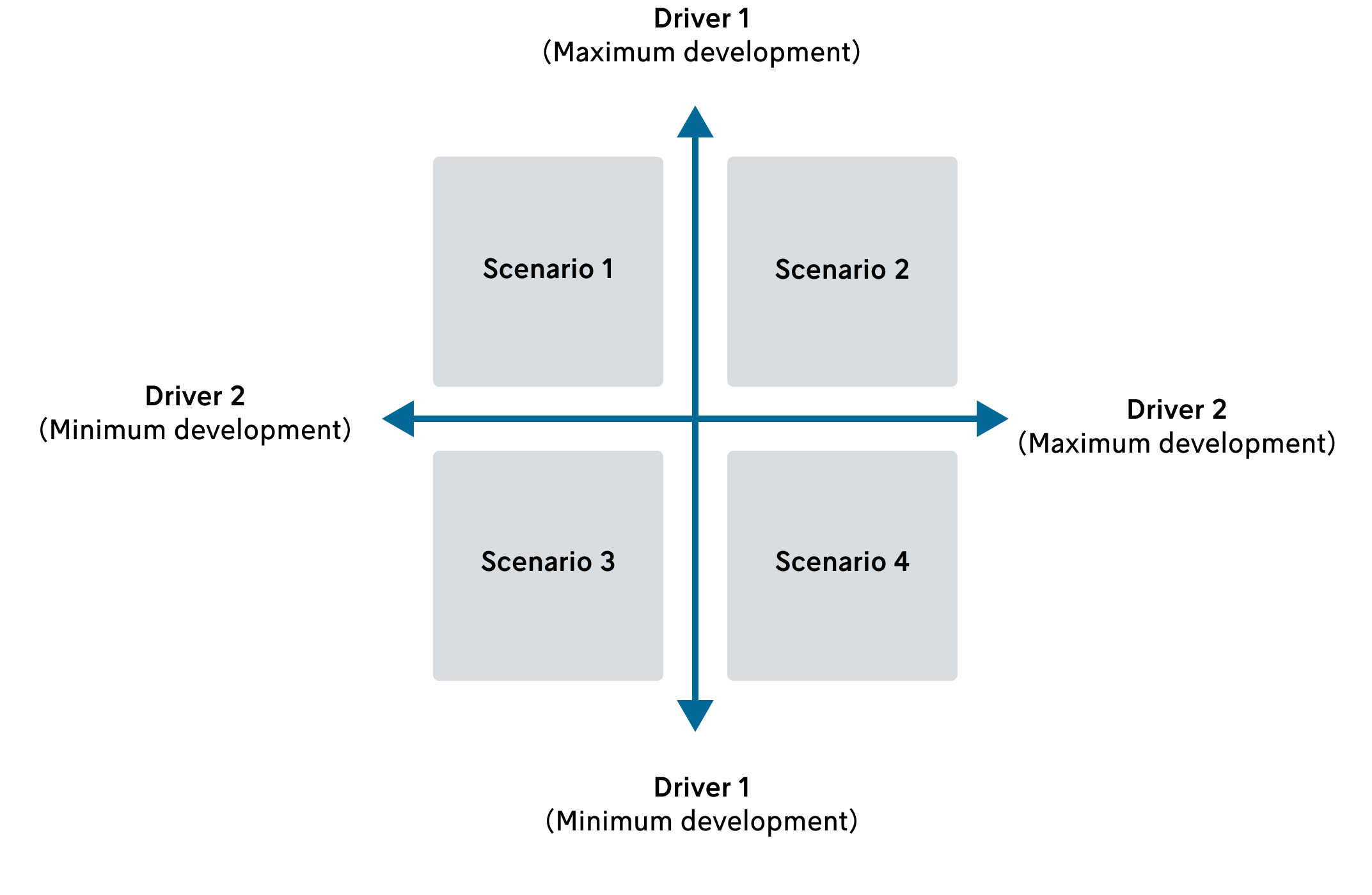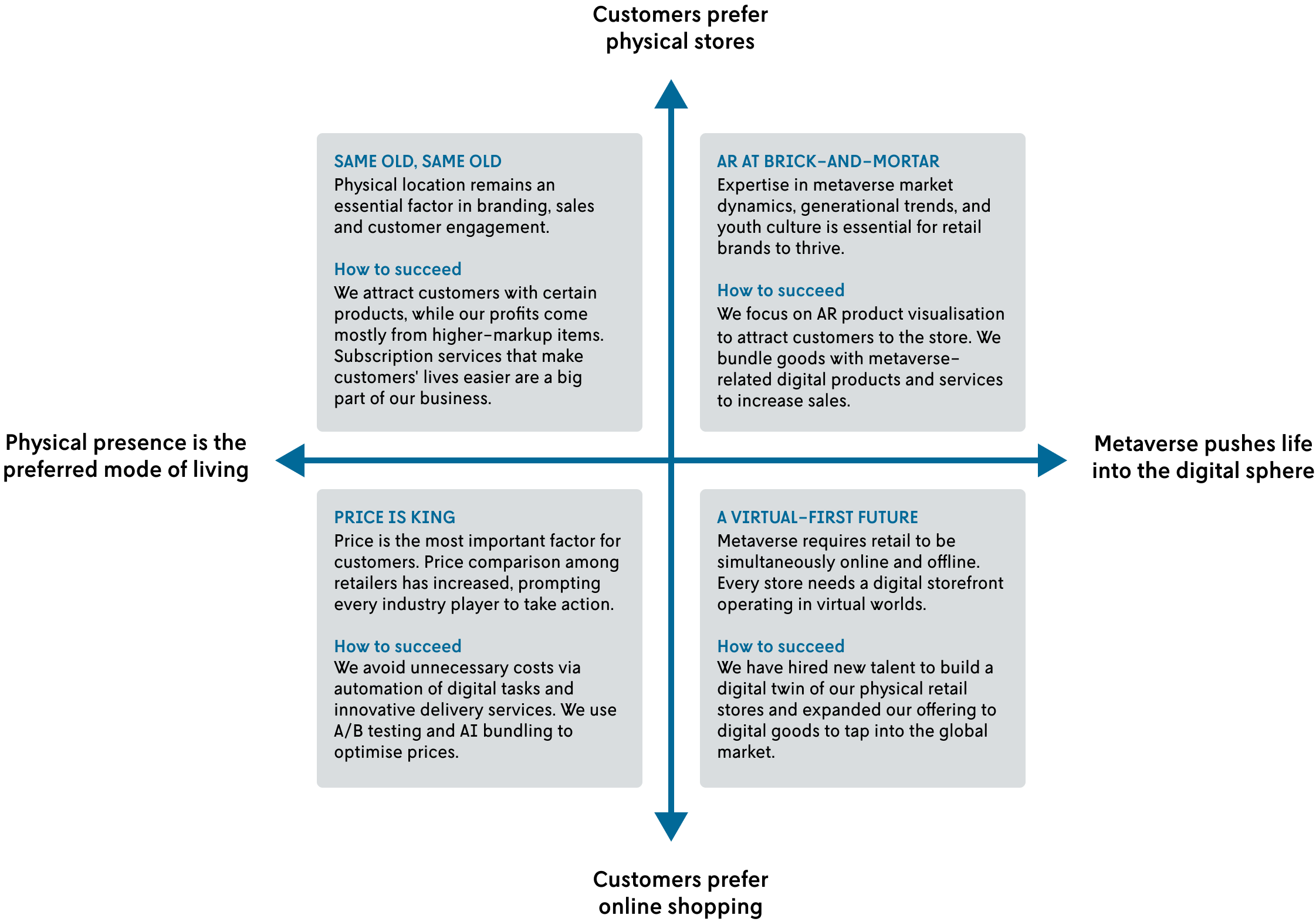2x2 Scenario Planning Matrix: A Step-by-Step Guide
Learn how to build plausible, engaging and actionable scenarios with an easy-to-use scenario planning framework.
About the Author
Max Stucki works as the Foresight Analysis Manager at Futures Platform. He is responsible for supervising and developing the foresight analysis process. He has worked with numerous clients to help them prepare for the future.
FUTURE PROOF – BLOG BY FUTURES PLATFORM
The 2x2 scenario matrix is one of the most popular and widely used scenario planning templates. The model utilises key drivers and uncertainties to construct simple, quick, but informative scenarios. From product & service development to strategy and risk management, the resulting scenario descriptions can be used for many purposes.
Scenarios are powerful tools that transport us to the future and enhance our ability to imagine multiple alternative futures. In organisational settings, scenario analysis has three main benefits: First, scenarios help you think about future changes systematically. Second, they promote an understanding of how potential future changes may affect your plans. And third, they let you see the current situation in a new light, uncovering new possibilities.
As a simple and versatile tool, the 2x2 scenario matrix model is well suited for multiple uses. While it’s mainly used for strategic future analysis needs, it’s also possible to adapt it for operational and tactical purposes. Applying the model to your specific needs may require some modifications, but the broad outlines of the concept still apply.
Subscribe to our weekly newsletter
HOW TO WRITE SCENARIOS WITH THE 2X2 SCENARIO PLANNING MATRIX
To get started with the 2x2 scenario planning process, you first need to determine the question you want to investigate. For example, you may take a broad approach and explore the possible futures your organisation may face by a certain date, e.g., in five years’ time. Alternatively, you may want to examine a more specific future question, such as “How will the metaverse impact our in-store retail strategies by 2030?”.
Once you’ve decided on the key research question you want to explore, start searching for the key driving forces that will be influential in shaping the future of your topic within the chosen time horizon. You can do this using the horizon scanning method, where you scan your operational environment for trends, uncertainties and early signals of change from multiple angles.
After spotting a set of drivers, choose the two most crucial ones. The drivers should be such that their future directions will have a substantial impact on your organisation’s strategies, business model, or operations.
Then draw a matrix, with each line in the matrix representing one driver. Next, define the ends of the drivers: think of them as a spectrum with two extremes.
Now your scenario planning framework is ready! The next step is writing the scenario narratives. In each quadrant, describe how things could happen within the given parameters. Depending on the goal you want to achieve with this scenario planning exercise, you can do this either from a general perspective or from your own organisation’s viewpoint.
In each scenario, focus on describing the changes relevant to you. The scenario descriptions don’t have to be long. Just communicate the main message in a coherent, plausible, specific, and engaging narrative. Once your scenario narratives are ready, give a title to each scenario that crystallises its unique characteristics – and you’re done!
SCENARIO ANALYSIS EXAMPLE: THE FUTURE OF RETAIL IN THE METAVERSE
Let’s take a look at a scenario planning example to give you a more detailed look into how the process works. This example is a highly general one and applying this to your context will most likely require additional work, but it can help get you started in your own scenario-building work.
We are now looking at the future of a retail company. The company feels that its future will be particularly affected by the changes in retail channels and the advent of the metaverse. So, these will be the key drivers we’ll use in building the scenarios.
Next, we define the spectrum ends. For the retail channel, they are:
Customers prefer physical stores
Customers prefer online shopping
And for the metaverse driver:
Metaverse pushes life into the digital sphere
Physical presence is the preferred mode of living
Now that the drivers and spectrum ends have been defined, it’s time to build the scenarios. The company wants the scenarios to contain two brief perspectives. In each scenario, the first paragraph describes what the operating environment in that particular scenario will look like, and the second paragraph outlines a concrete action plan on how the organisation can succeed in the described future. As usual, each scenario has a title that encapsulates its core idea.
HOW TO USE SCENARIOS IN ORGANISATIONAL STRATEGIES
One of the most common questions I encounter in scenario workshops is, “How do I use the scenarios?”.
The use of scenarios depends on your need. If you want to understand how your strategy would perform in the future, compare it to each scenario. Evaluate the robustness of your strategy under each scenario, and consider if you need to change something or develop new strategies to meet any future contingency.
Another way is to understand how your supplier, clients and competitors might act in each scenario. What should you prepare for? What new customer behaviours, risks and opportunities may arise in each scenario?
The key point is that scenarios map the possible future. They help you see what you should start doing now to succeed tomorrow.
KEY TAKEAWAYS
2x2 matrix is a powerful yet easy-to-use scenario planning tool
Define your main drivers and their spectrum ends
Write scenarios based on the combination of those spectrum ends
Use the scenarios, e.g., to stress-test strategy, anticipate customer behaviour, or detect future supplier problems







Before the world caught on, Givaudan was already designing the taste experiences of tomorrow. We sit down with Igor Parshin, Customer Foresight Lead at Givaudan to talk about how the company uses foresight to turn early change signals into the flavours that will define the future.